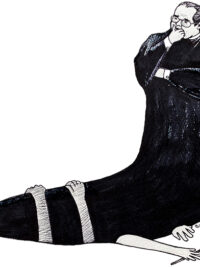Review Essay: Chile After Allende
In the 2019 UK General Election, beleaguered by a concerted campaign of print and broadcast media attacks, enfeebled by in-party subterfuge, and twisted inside out over how to resolve the salient issue of Brexit, a ragged and limpen Labour Party succumbed to a heavy defeat. Jeremy Corbyn, the first politician proposing a break from neoliberal orthodoxy to front a major European political party in a generation, was finished.
In the days that followed, Financial Times journalist Jim Pickard recorded Shadow Chancellor John McDonnell in an ill-judged attempt at levity, claiming: “Normally when a socialist revolution fails, they all get taken to a football stadium and shot, at least that hasn’t happened this time.” McDonnell was referring to Santiago’s Estadio Nacional, the venue that played host to the 1962 FIFA World Cup Final; which just over a decade later, found itself repurposed into a makeshift torture and execution facility, following General Augusto Pinochet’s coup d’état that removed the world’s first democratically elected socialist head of state Salvador Allende.
Though never intended to be taken seriously, McDonnell’s quote demonstrates how the trauma of what happened on September 11, 1973, still resonates among the left. Chile under Pinochet would become a Petri dish for the Chicago Boys’ economic reforms, made globally hegemonic through Ronald Reagan and Margaret Thatcher. Overpowered, and often violently suppressed, the left and its advocates withered into obscurity and entropy; fifty years on, the collective grief in Chilean culture over what was lost remains raw and irresolvable.
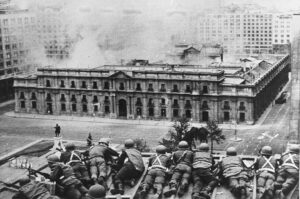
September 11, 1973: As bombs fall, and smoke rises, Chilean troops prepare to storm Palacio de La Moneda, the Presidential residence.
Salvador Allende and Augusto Pinochet have found themselves the subject of two very different fictional portraits, released to mark the fiftieth anniversary of the coup. Ariel Dorfman’s autofiction novel The Suicide Museum, takes place largely in the aftermath of Pinochet’s abdication in 1990, and portrays a writer (also named Ariel Dorfman) returning from exile to Chile. At the request of a Jewish, Dutch billionaire, Dorfman is dispatched to uncover the truth behind what was long considered to be dictatorship propaganda: as Pinochet’s troops stormed the Presidential residence, Palacio de La Moneda, Allende committed suicide by shooting himself with an AK-47 gifted to him by Fidel Castro. In a cryptic disclosure, Dorfman is informed that resolving the mystery of Allende’s death will help with the billionaire’s messianic project to save humanity from climate change.
Through fictionalising his own experiences, Dorfman attempts to wrench Allende from the realm of reverential myth and return him to the plain of history; contesting and re-examining his own hero worship, which shades gradually into an exploration of national guilt.
Pablo Larrain’s vertiginously surreal horror film El Conde (The Count), takes the exact opposite approach: transporting the historical figure of Pinochet into the realm of mystical unreality. Narrated in admiring tones by the immediately recognisable stern, humourless drawl of Margaret Thatcher, we learn that Pinochet did not die in 2006, but lives on today in rural Chile as a 250-year-old vampire.
Pinochet came of age during the French Revolution, becoming so enamoured by Marie Antoinette’s blithe indifference towards the cruelty and suffering inflicted upon her own people, that following her execution, he devotedly licked her blood from the guillotine blade and took her head for himself; pledging to spend eternity avenging her, by devouring pleasure in the oppression of democratic sentiment. Eventually settling in Chile, a land of “fatherless peasants,” making it a ripe and opportune feeding ground for what would become his brand of state-sponsored corporate kleptocracy, where Pinochet himself would plunder a sizeable personal fortune.
Filmed in sunless black and white, El Conde’s stark compositional arrangements evoke the silent-era films of Dreyer and Murnau, compounding the feeling of a present that exists trapped outside of time. The exultant sounds of Vivaldi’s Four Seasons are pierced by the noise of Pinochet’s cape fluttering in the wind, as he glides over Santiago hunting for prey. A spectre of darkness webbing down like a spider out of an ink black sky to feed upon modern-day Chileans. An undying dread looming over the present; a legacy that cannot be killed. It’s significant that what provides the richest sustenance for Pinochet is the blood, and specifically the ripped-out hearts of the young.
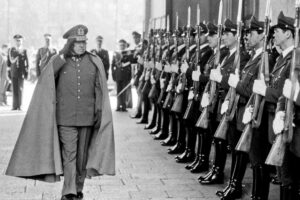
Upon seizing power, and ending democracy, Pinochet would promote himself to the invented rank of Captain General. His signature vampiric cape was intended to evoke the great emperors of antiquity.
Although Pinochet ceded power in 1990, the economic system he helped construct has largely remained in place. In the 1970’s there were eight universities in Chile, by 2019 there were 150, although two-thirds of those were run by private firms for profit. Chile spends 0.5% of GDP on higher education, the lowest in the OECD. Whereas the cost of a university degree is 41% of average income, the highest in the OECD, meaning that many young Chileans simply cannot afford the price of tuition. Even with so many more universities to choose from, opportunities to scale the economic ladder have been curtailed, not widened. With spiralling higher education costs acting as a tax on social mobility; in 2022, 18% of people between 18-24 were not in employment, education, or training, well above the OECD average. The core promise of neoliberalism that increased private competition would improve quality of service, while simultaneously driving down costs for consumers, proved to be nothing but smoke and mirrors.
A story repeated across almost every sector of the Chilean economy: a transfer of control, oversight, and revenue from public into private hands, while a steady stream of state subsidies and condition-free bailouts meant private debt was offloaded into public hands. The visual legacy of these neoliberal reforms has rendered our lived environments into ideal dwellings for undead ghouls: as multinational conglomerates have taken charge of manufacturing industries and sent jobs overseas to save on labour costs, de-industrialised cities have become ringed by ghostly, uninhabited factories and decrepit, decaying infrastructure. While the wealthy elites reside in ever higher, ever more iniquitous skyscrapers; looming over the lowborn townsfolk below like a Transylvanian castle on a hilltop.
Following a nationwide campaign of street protests demanding change, a 2020 referendum resulted in 78% of voters agreeing to replace their constitution, drafted in 1980 under Pinochet’s rule. Yet the resultant 2022 referendum to ratify a radically-minded, progressive constitution failed. The new constitution would have enshrined gender equality, ensured protection of indigenous communities, and made public universities free, as well as making Chile one of the first nations on earth to prioritise climate policy and action within a written constitution.
Unsurprisingly, the campaign to reject the new constitution was heavily bankrolled by finance and business interests, who outspent the accept campaign by three to one. In an unknowingly felicitous reference to El Conde, Colombian President Gustavo Petro went as far as to say the new constitution’s defeat meant Chileans had made the choice to: “Revive Pinochet.”
During one sequence in El Conde, Pinochet strides across a black and white square-tiled floor, triumphant, but solitary as the lone King remaining on a chessboard; weary and isolated, the 250-year-old wishes only to be allowed to die. There is a degree of truth to Pinochet being some sort of unfathomable, indestructible other: in 1986 he survived an assassination attempt when guerilla rebels fired a rocket-propelled grenade at his car, which miraculously failed to explode on impact.
The concept of having escaped the certainty of one’s death, and the concomitant isolation of survivor’s guilt, is a central theme in both El Conde and The Suicide Museum. The real Ariel Dorfman served as a cultural advisor in Allende’s cabinet, and as the situation began to deteriorate with an armed insurrection becoming ever more likely, he was due to stand watch at Palacio de La Moneda the night before the coup, but swapped shifts with his friend and colleague, Claudio Jimeno. After the coup, Dorfman went into hiding in the Argentinian Embassy, sleeping under a billiard table, before eventually escaping into exile in Paris; while Jimeno would become one of the first of 1,469 people who disappeared under the Pinochet regime, never to be seen again.
Jimeno could well have spent his final days at Colonia Dignidad, a cult-like colony set up by ex-Nazis following World War II, which under Pinochet’s regime would play host to a secret prison camp. The colony’s leader was ex-Nazi Paul Schäfer, who fled West Germany for Chile in 1959, after he was charged with paedophilia. He would eventually be convicted on 25 counts of abusing children in 2005. Schäfer often claimed he lost his right eye in the war, but in actual fact had accidentally gouged out his own eye, while trying to remove a stubborn shoelace with a fork.
Next to the scarcely believable truths of the Pinochet regime, where one-eyed, paedophile ex-Nazi, cult-leaders oversaw secret prison camps, the idea of nightmare creatures like vampires entering into the same waking reality can begin to feel not so outlandish after all. To this day, despite the efforts of numerous investigations, including a National Search Plan recently set up by President Gabriel Boric, the remains of those who disappeared have never been found.
Dorfman wrote for the LA Times in 2020: “I have often fantasized about how different the world would be if Allende had not been overthrown […] I wonder where humanity would be if his peaceful revolution had been allowed to run its course and become a template for other countries.” While Dorfman also accepts that it is naïve to imagine that Allende as President of a mid-weight Latin American nation, could have forestalled Milton Friedman and the Chicago Boys’ corrosive economic experiment spreading across the world.
Nonetheless, Dorfman in The Suicide Museum is forever sifting through the lost promises of Allende’s ambitious agenda to nationalise Chile’s partly-US owned copper mines (in 1973, Chile was the third largest producer of copper in the world, behind only the USA and Zambia), while also expanding educational access, equitably redistributing farmland, and enacting state control over strategic industries and the banking sector. Allende’s government even had the remarkable foresight to develop a 1970’s proto-internet in Project Cybersyn: which attempted to centralise economic data, manage the performance of factories, and formulate responses to emergencies, in a radically future-minded vision of an interconnected, tech-powered economy.
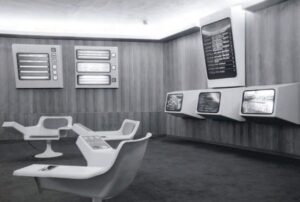
A concept for the command HQ of Project Cybersyn, clearly evocative of Gene Roddenberry’s Star Trek, 1966-69.
Right-wing opponents of Allende, such as former Editor of The Sunday Times newspaper Andrew Neil, have written about the dire state of the Chilean economy in Allende’s final days; or that the democratic mandate for his revolutionary agenda was hardly unanimous: crawling across the finish line to victory with only 36% of the vote after a razor tight three-way race in the 1970 presidential election; or that far from acting as a beacon of democratic freedom, Chile under Allende would have inevitably become a puppet state of the brutal communist dictatorships in Moscow and Havana.
Neil also argued against Pinochet’s 1998 arrest in London under an international warrant issued by a Spanish judge, for his involvement in the killings of 194 Spanish citizens: “What is ethical about arresting an 82-year-old has-been dictator, who relinquished power without a struggle and bequeathed a prosperous economy to his democratic successors[?]” Neil goes on to declare that Pinochet: “merits little more than a footnote in the roll-call of brutal dictators.” Although Neil does not include any statistics to support this claim; there were an estimated 41,470 victims of detention, torture, disappearance, and extra-judicial executions under Pinochet’s regime, though the true number may never be known. In a rare moment of factual history depicted in El Conde: Margaret Thatcher would emerge from the shadows of political retirement in 1998, wielding her considerable political capital and influence to publicly defend Pinochet, calling his prosecution: “a tragedy.”
Whatever his views on Pinochet, what Neil’s analysis of Allende’s government neatly overlooks is the extent to which it was hexed from the very beginning by external interference. Outraged by Allende’s election, and determined to undermine any prospect of Chilean prosperity under socialism, President Richard Nixon ordered Richard Helms, the head of the CIA to: “make the economy scream.” Following the advice of his National Security Advisor Henry Kissinger, Nixon would authorise a multi-front economic war that would block multilateral bank loans to Chile, while also threatening to sanction any nation who dared purchase the newly nationalised Chilean copper.
In 2000, in the face of overwhelming evidence, the CIA was forced to admit its role in the murder of General Rene Schneider, the Commander-in-Chief of the Chilean Army, after he spoke out against those who wanted the Army to stop Allende’s inauguration. The vacated position of Commander-in-Chief would later be filled by General Augusto Pinochet; although in a cruel twist: it was Allende who appointed Pinochet.
As Naomi Klein in The Shock Doctrine points out: “The dirty secret of the neoliberal era is that these [socialism’s] ideas were never defeated in a great battle of ideas, nor were they voted down in elections. They were shocked out of the way at key political junctures. When resistance was fierce, they were defeated with overt violence – rolled over by Pinochet’s, Yeltsin’s and Deng Xiaoping’s tanks.” Whereas the Pinochet of El Conde is unkillable, and with the aid of his powerful friends, untouchable by any attempts at legal, financial, or even religious justice; in The Suicide Museum, from the day he was born in 1908,Allende was: “perhaps already destined to die in the Presidential Palace.”
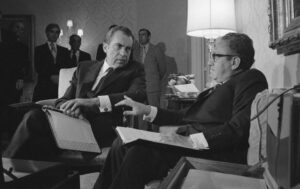
Nixon and Kissinger were determined to prevent Chile from becoming an example to other nations for a democratic pathway to socialism, and worked with the CIA to create the conditions of possibility for the coup.
One curious feature of The Suicide Museum is that unbeknownst to the characters throughout the predominantly 1990-set novel, but public knowledge to readers today, is that the whodunnit over Allende’s death was resolved following a 2011 autopsy, which concluded suicide. The novel offers a mystery riddled with contradictions and strange connections: in one flashback sequence, Dorfman recounts a meeting with Allende, who encouraged him to hold the AK-47 mounted on the President’s office wall; symbolically linking his past self with his future role as investigator: his own fingerprints were on the murder weapon.
The Suicide Museum confronts why Allende’s supporters might find comfort in the fantasy of their idol falling to a hail of gunfire with glorious valour and courage, evoking the defiant spirit of two iconic outlaws killed in the neighbouring state of Bolivia: Butch Cassidy and The Sundance Kid. How the fantasy relates to Chile’s preeminent wartime legend, which is of defeat, not victory: Naval Commander Arturo Prat and his crew refusing to surrender in the face of insurmountable odds, instead choosing to fight to their deaths at the Battle of Iquique.
The real mystery of the novel is not Allende’s cause of death, but why Joseph Hortha, a Jewish, Dutch billionaire, with tenuous connections to Chile, would be so invested in answering that question. Hortha is a holocaust survivor, whose mother died at Treblinka, and bonds with Dorfman over their shared guilt at having survived, when better, more deserving people around them perished. Yet Dorfman remains conflicted over taking a pay-check from a billionaire: “all excessive money is tainted, most of it can be traced back to some form of suffering that has been erased, made invisible.”
There are 3,194 billionaires in the world today, and the richest 81 among them own more wealth than the bottom 50% of the world’s population combined. There is something untethered and illusory about the aura contained within these people: floating freely outside the borders of structured, contained reality that the rest of us inhabit, possessing many vampiric qualities, not least the belief that the omnipotent power of their wealth will eventually grant the power to escape death.
Hortha is no exception. In order to repent for having made his fortune in manufacturing plastics, personally profiting 0.01 cents on every non-degradable supermarket plastic bag made around the world, Hortha’s ludicrous fantasy project to save himself and humanity from the existential threat of climate change, is to construct a sprawling exhibition space, featuring a portrait gallery of both real and fictional acts of suicide. Spanning every conceivable epoch and motive: from Vincent van Gogh to Romeo and Juliet, from Marilyn Monroe to Anna Karenina, from Adolf Hitler to Antigone; stories from Masada to Jonestown, from Japanese kamikaze pilots to the Belfast Maze Prison hunger strikes, culminating in scenes of a polluted earth, set ablaze by mankind. Hortha’s belief is that upon exposure to all this (the novel’s roll call of names lasts several pages), visitors will make the epiphanal realisation that our species, through its continued commitment to inaction in the face of a climate emergency, is choosing to march into oblivion. That we are all complicit in civilisational suicide.
A preposterous idea, but a vision built upon faith in our collective spirit and virtue; El Conde meanwhile, offers no such hope. Diverging from the conclusions of Sheridan Le Fanu’s Carmilla, or Bram Stoker’s Dracula, with El Conde, director Pablo Larrain contends that no force on earth, not even the power of God contained within Carmen the nun (who bears a deliberate resemblance to Renée Falconetti in Dreyer’s The Passion of Joan of Arc) can hope to kill the malevolence contained within the vampire Pinochet.
He will only liquify and mutate, assuming new forms across time, finding fresh willing allies: from a White Russian butler, eager for any opportunity to torture and kill Chilean “Bolsheviks” to avenge Tsar Nicholas II, to Margaret Thatcher and her mission to create a world of individualised mercenaries, incentivised to view one another as competitors and subsequently eliminate the concept of a shared society. The final words of El Conde underline the national project Pinochet was able to build upon Allende’s grave: “Beyond the killing, his life’s work was to turn us into heroes of greed.”

No accident: Paula Luchsinger as Carmen in El Conde, 2023 (Left) and Renée Falconetti as Joan of Arc in The Passion of Joan of Arc, 1928 (Right).
Chile’s present-day miasma does bear some resemblance to the dim, ominous, nowhere-world of El Conde. Right-wing opposition parties continue to defend and justify the coup, while in September, opposition leaders refused to sign a government-sponsored commitment to democracy. Next month, one more referendum will be held on whether to ratify a scaled back version of the rejected 2022 constitution. However, polling indicates this amended version is also likely to be rejected.
It’s a common ailment: we are living through an era of unending economic shocks, climate emergencies, mass protests on a historic scale, and perception-altering events like a once in a century global pandemic, yet we wake up the next day and discover that nothing has changed. The vampires who helped make things this way live on into eternity, while no matter how many different ways we try to re-imagine the story of resistance: John Henry always dies in the end.
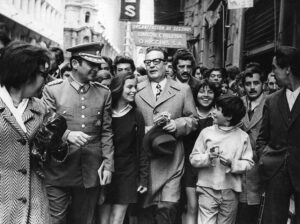
President Salvador Allende, walking the streets of Santiago, shortly before his death on September 11, 1973. He was popular with children, after instituting a policy to provide every school child with half a litre of milk a day.
Towards the conclusion of The Suicide Museum, Dorfman visits Highgate Cemetery in London, the resting place of Karl Marx, and as he walks among the ruined dreams of those revolutionary ideas, he has a revelation: his investigation will not reveal the version of Allende’s death that he believes to be true, instead he will make use of his “compassionate imagination” and print the legend. But why go against his own instinct, as well as the version confirmed by forensic science, when we all know this wasn’t what really happened? Perhaps in the end, Dorfman does find inspiration in the reasoning behind Hortha’s suicide museum: “humanity doesn’t require rational arguments, piles of scientific data, news bulletins, equations and formulas and mathematical axioms, none of that has troubled our consciousness. But a chilling story, that’s another matter. Technology changes our bodies, but storytelling, ah, that changes our minds. Right?”

